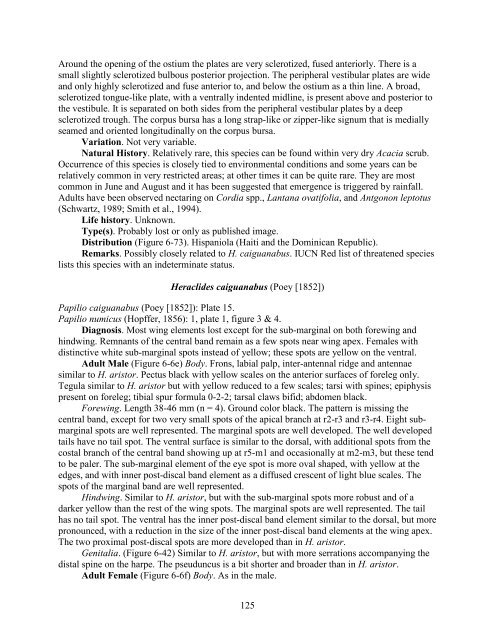Phylogeny & Revision of the genus Heraclides
Phylogeny & Revision of the genus Heraclides
Phylogeny & Revision of the genus Heraclides
You also want an ePaper? Increase the reach of your titles
YUMPU automatically turns print PDFs into web optimized ePapers that Google loves.
Around <strong>the</strong> opening <strong>of</strong> <strong>the</strong> ostium <strong>the</strong> plates are very sclerotized, fused anteriorly. There is a<br />
small slightly sclerotized bulbous posterior projection. The peripheral vestibular plates are wide<br />
and only highly sclerotized and fuse anterior to, and below <strong>the</strong> ostium as a thin line. A broad,<br />
sclerotized tongue-like plate, with a ventrally indented midline, is present above and posterior to<br />
<strong>the</strong> vestibule. It is separated on both sides from <strong>the</strong> peripheral vestibular plates by a deep<br />
sclerotized trough. The corpus bursa has a long strap-like or zipper-like signum that is medially<br />
seamed and oriented longitudinally on <strong>the</strong> corpus bursa.<br />
Variation. Not very variable.<br />
Natural History. Relatively rare, this species can be found within very dry Acacia scrub.<br />
Occurrence <strong>of</strong> this species is closely tied to environmental conditions and some years can be<br />
relatively common in very restricted areas; at o<strong>the</strong>r times it can be quite rare. They are most<br />
common in June and August and it has been suggested that emergence is triggered by rainfall.<br />
Adults have been observed nectaring on Cordia spp., Lantana ovatifolia, and Antgonon leptotus<br />
(Schwartz, 1989; Smith et al., 1994).<br />
Life history. Unknown.<br />
Type(s). Probably lost or only as published image.<br />
Distribution (Figure 6-73). Hispaniola (Haiti and <strong>the</strong> Dominican Republic).<br />
Remarks. Possibly closely related to H. caiguanabus. IUCN Red list <strong>of</strong> threatened species<br />
lists this species with an indeterminate status.<br />
<strong>Heraclides</strong> caiguanabus (Poey [1852])<br />
Papilio caiguanabus (Poey [1852]): Plate 15.<br />
Papilio numicus (Hopffer, 1856): 1, plate 1, figure 3 & 4.<br />
Diagnosis. Most wing elements lost except for <strong>the</strong> sub-marginal on both forewing and<br />
hindwing. Remnants <strong>of</strong> <strong>the</strong> central band remain as a few spots near wing apex. Females with<br />
distinctive white sub-marginal spots instead <strong>of</strong> yellow; <strong>the</strong>se spots are yellow on <strong>the</strong> ventral.<br />
Adult Male (Figure 6-6e) Body. Frons, labial palp, inter-antennal ridge and antennae<br />
similar to H. aristor. Pectus black with yellow scales on <strong>the</strong> anterior surfaces <strong>of</strong> foreleg only.<br />
Tegula similar to H. aristor but with yellow reduced to a few scales; tarsi with spines; epiphysis<br />
present on foreleg; tibial spur formula 0-2-2; tarsal claws bifid; abdomen black.<br />
Forewing. Length 38-46 mm (n = 4). Ground color black. The pattern is missing <strong>the</strong><br />
central band, except for two very small spots <strong>of</strong> <strong>the</strong> apical branch at r2-r3 and r3-r4. Eight submarginal<br />
spots are well represented. The marginal spots are well developed. The well developed<br />
tails have no tail spot. The ventral surface is similar to <strong>the</strong> dorsal, with additional spots from <strong>the</strong><br />
costal branch <strong>of</strong> <strong>the</strong> central band showing up at r5-m1 and occasionally at m2-m3, but <strong>the</strong>se tend<br />
to be paler. The sub-marginal element <strong>of</strong> <strong>the</strong> eye spot is more oval shaped, with yellow at <strong>the</strong><br />
edges, and with inner post-discal band element as a diffused crescent <strong>of</strong> light blue scales. The<br />
spots <strong>of</strong> <strong>the</strong> marginal band are well represented.<br />
Hindwing. Similar to H. aristor, but with <strong>the</strong> sub-marginal spots more robust and <strong>of</strong> a<br />
darker yellow than <strong>the</strong> rest <strong>of</strong> <strong>the</strong> wing spots. The marginal spots are well represented. The tail<br />
has no tail spot. The ventral has <strong>the</strong> inner post-discal band element similar to <strong>the</strong> dorsal, but more<br />
pronounced, with a reduction in <strong>the</strong> size <strong>of</strong> <strong>the</strong> inner post-discal band elements at <strong>the</strong> wing apex.<br />
The two proximal post-discal spots are more developed than in H. aristor.<br />
Genitalia. (Figure 6-42) Similar to H. aristor, but with more serrations accompanying <strong>the</strong><br />
distal spine on <strong>the</strong> harpe. The pseuduncus is a bit shorter and broader than in H. aristor.<br />
Adult Female (Figure 6-6f) Body. As in <strong>the</strong> male.<br />
125

















